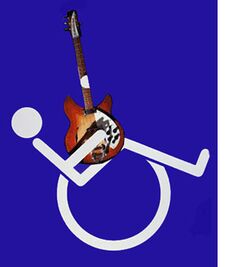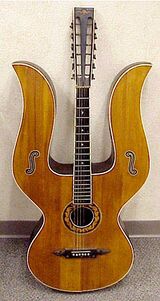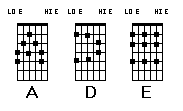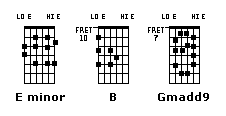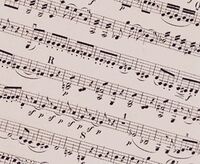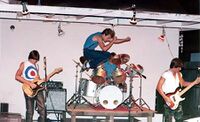HowTo:Learn guitar
| This article is obviously created by someone who is Fucking Rad, which makes this article totally sweet. And awesome. |

|
HowTo This article is part of Uncyclopedia's HowTo series. See more HowTos |
“I broke my G-string while fingering A minor”
Many guides claim to teach beginners how to play guitar. They don't work, because they assume that people are stupid enough to read through endless pages of scales, time signatures, clefs, fingering charts, music theory and other useless rubbish. Professional teaching is also expensive, costing up to £40 a lesson ($350). These are also largely ineffective as they place undue pressure on the learner and excessive emphasis on technique and theory.
For the benefit of this guide, it is assumed that the reader does not yet know the first thing about the instrument. It is also free while stocks last, so get it while it's hot.
That said, why are you even bothering with this article? Why don't you just pick up a guitar and learn a couple of songs (badly), attempt a couple of chords (even more badly), walk around telling everyone that you can play the guitar, and quit after a month?
It's what everyone else does.
Requirements for playing the guitar
- A guitar (optional - See air guitar) with strap.
- A plectrum: piece of plastic existing for the sole purpose of falling in the sound hole (also optional). In reality, you need about twenty, as they usually end up as tasty snacks for the family dog or lost down the back of the sofa.
- An addiction, such as cigarettes, alcohol, LSD, marijuana, heroine, cocaine, cake, nachos, sex, Evil Cybernetic Koalas n' Gravy, The Clash or cocaine. The greater your dependence, the better your music becomes. Guitarists in need of hardcore drugs should consult their band's drummer.
- Patience this track from the Guns N' Roses Lies album is a favorite first song.
- Rock star attire. Exact garments vary from headband and waistcoat combination to nothing at all. Do not worry too much about this, however, as whatever you wear, the guitar instantly makes you a rock God.
- Cool. This is the most essential requirement of all. Definition of 'cool' varies, but in general it is a good idea to observe the masters of the stringed instrument: George Formby and Billy Connolly.
- A Fantasy Life. Unlike all the other losers at the music store you are going to be the one that becomes rich and famous.
- A Guitar forum account. You will need a place to pronounce your greatness. Be sure to bost about attaining Slash's sound by using a complex system of switches, Plastic tubing and a 12 oz. jar of GrapeJelly. Also make sure to borrow pictures from other websites and proclaim that gear to be your own. Nothing makes you look cooler than other peoples stuff.
Holding the Guitar
This is relatively simple:
- Stand up. Many guides advise that the beginner should ideally sit when learning the guitar. It is imperative that this is not followed: sitting whilst playing seriously cramps your style and is not 'cool'.
- Place the guitar strap over the left shoulder.
- Look cool. This may or may not involve closing your eyes and looking into the air, administrating power stance and/or bending your knees in a Hendrix-esque fashion.
- Finally, it may be helpful to break your own fingers before playing a guitar, this will help reach those really hard chords. It is also useful for some beer money if you have previously insured them. Plus, you never have to cut your fingernails again.
Your pathway to massive credit card debt
Buying a Guitar
Alright. Now you need to pick your instrument.
Acoustic Guitars
These guitars are a favorite of hobos, Mexicans, and hillbillies. The lack of a need for an amp is perfect for those whose drug problem prevented them from paying the electric bill for the past six months. The sound hole is perfect for hiding a stash. In a pinch, an acoustic guitar can double as an improvised weapon for the inevitable fights that break out in redneck bars.
Electric Guitars
Three of the most popular styles of electric guitars are the Rickenbacker 4001, Fender Stratocaster and the Gibson Les Paul. One of those is a lie, because it is a bass. Guess which one for a prize!
The Fender Strat is a cheaply built guitar. Some say it gets its name from its main component: car fenders, but in actual fact it features a bolt-on neck to allow for shims to be used to compensate for all the warped necks the Fender factory produces.
For example, the 1978 Stratocasters featuring wood from used shipping pallets, pot metal bridge and tuners remelted from Chevy Vega carburators, pickguards made of plastic rejected from toilet seat manufactures (Strats with such pickguards bear the label "American Standard") , aluminium wiring, and used WW2 surplus jacks and potentiometers are now a classic guitar available from Fender as a reproduction for 2,500 dollars.
Gibson guitars are a typically poorly built guitar. Many attribute this to the fact they are hand built by Mel Gibson, who has resorted to creating musical instruments in his garage to tide him along when overacting roles are scarce.
Gibson guitars feature warped necks glued in place to avoid the expense of screws and shims, scratchy potentiometers and switches salvaged from broken TVs, frets made of steel from scrapped liberty ships and a bridge design inspired by a toilet paper holder. New guitars with dings, cigarette burns, and bad paint jobs due to hungover assembly line workers are part of the continuing Gibson tradition and thus are pre-requisite for a "vintage" guitar.
Gibson guitars are a favorite for jazz, blues, and hard rock. The inability of a Gibson guitar to stay in tune for more than five minutes is a bonus for jazz musicians, who never stay in key anyways. The complete lack of intonation does not affect blues playing, nor hard rock, as usually a maximum of two strings are ever strummed at once. Gibson guitars are usually played with high distortion to mask the fact they sound horrible without it.
Bass guitars
(The Rickenbacker is the bass. Lucky guess.... What? You actually thought you were going to get a f*cken prize?)
Bass guitars are not strictly guitars but the mentally-challenged offspring of a Hawaiian Electric Guitar (excellent for a-slippin' and a-slidin' with!) and a rather obese Double Bass. Basses are created by exposing a normal Fender guitar to Heavy Metal, causing it to deteriorate in its mental health (to protect guitars from this, plaster them with scary-looking stickers and patterns). This gives it a bigger head, thicker strings and causes the string vibrations to slow down to half the speed.
Basses require a separate type of amplifier because normal amplifiers look down on the instruments as being slow and difficult to work with. Indeed, some amplifiers like the Fender Bassman have turned themselves into guitar amplifiers. When rigged to the right amplifier however, it can create a deep, strong sound that whilst is barely audible on records, in a live concert this 'growl' can fill the room and control the entire band, create an infectious rhythm, penetrate through walls and draw people in outside into dancing like someone off The Office or banging their heads against the thin air. MWUHAHAHAHAHAHA!!!!!
Buying an amplifier
One of the most important accessories required for an electric guitar to function is the amp. The amp you buy can turn an average-sounding guitarist into an internationally-renowned rock star. Ensure that it has an 'overdrive' option and a very loud volume setting: these factors, as one can imagine, are highly essential. Make sure that the amplifier has a huge sign that says '5000 W' or more, and has flashy stickers all over showing that you have played around the world.
History of Fender amps in brief
In the early years the design of Fender amps was plagiarized from the ridiculously simple sample circuits vacuum tube manufactures put in their datasheets, never intended to be the basis of a design of a good amplifier. However, these crappy-sounding amps combined with their equally crappy guitars were used by a couple of good musicians, and thus the combination of sounds has become part of Americana during the 50's and 60's. Today these old amps (which currently pose a great electrocution hazard) are a collectors' item. Currently there is a debate among the enthusiasts of these old amps over whether mouse droppings inside the speaker cabinet from mice in the late 50s give a warmer tone compared to the droppings deposited by mice in the 1970s. Vintage mouse fecal matter fetches high prices on eBay these days.
Let the noise complaints begin
Tuning
Usually, the guitar is in tune when you receive it: workers at the guitar factory tune all guitars before sending them to retailers. Budget models, however, are likely to have been detuned by rapscallions at the shop. If this is the case, tuning of the guitar is achieved by twisting the knobs at the top end of the guitar. It is recommended that an experienced guitar player do this for you.Basically, a guitarist who KNOWS how to play should do this for you. New guitars usually go out of tune easily and require frequent tuning. Don't allow this to let you down: it's only because you suck. It is recommended to buy a tuner to do this, or simply tell your mama to work her magic. Once the strings are "seasoned", tuning need only be done once every 3-4 weeks, which is more often than you having sex since you spent time reading this crap.
Technique
Always practice in front of a mirror to check coolness.
Place your left hand on the guitar neck, and your right hand hovering over the sound hole. Use the fingers on your left hand to press the strings onto the frets (metal bits) in a random fashion.
Basic strumming pattern: Thrash your right wrist in a vertical/diagonal motion across the strings. Don't worry if you don't make contact with them: this is not an essential requirement of playing the guitar. This also does not need to be in any particular time.
Intermediate strumming pattern: Thrash your right hand up and down over the sound hole whilst wiggling your fingers in a random way from time to time. It is optional whether you jump up and down, though in some cases this can cause personal injury.
Advanced strumming pattern: Perform each of the above. Remember to raise your hand above your head to the greatest extent possible at the end of each bar of 8, before rapidly bringing it back down again to the lowest possible point, attempting to contact each of the strings along the way. Doesn't really matter if you don't, as long as it looks flashy because guitar playing is all about style.
Learning Chords
This is not a complete necessity, though it is useful to learn, as it allows you to 'show off' and brag to others about how many chords you know. They also provide a pleasant variation from the standard chord that comes tuned with the guitar. A 'chord' is played by placing fingers on your left hand (or, if you play left-handed, your right hand) behind the frets in a set pattern. There are only three chords you need to know. Using these in any order automatically will make your playing sound much more outstanding.
Simply follow the diagrams for A, D and E chords to the right, placing your fingers on the frets indicated by the dots, and you will be well on your way to a number one single, except at Christmas, for obvious reasons.
There are other chords, but these are so difficult only the most experienced guitarists can handle them. As is evident from the diagram above left, these are very difficult to learn. Once you have been playing for ten years, you may have a chance of learning them. There exist only seven people who can play more than five chords - they are multi-millionaires that have insured their hands for thousands of dollars.
Some guitarists, particularly beginners, will often complain that all chords are hard, or indeed that it looks like some chords require upwards of nine fingers per hand. This is the sort of pettiness that separates future guitar legends from those destined to teeter away their lives peddling guitars to people with real talent. Which group will you be in?
Create an article about yourself on Wikipedia
Now that you know some chords it is now time to create an article about yourself on Wikipedia. Don't let the speedy deletions get you down. The trick to staying is writing a line in your article stating that you have "albums released by an independent label." This will stifle most wikipedia admins. If you don't want to lie, attempt to sell recordings of your practice sessions on a street corner.
Playing a solo
Always make sure the door to the room you are practicing in is locked to avoid injuries to family members, pets and dopey burglars.
Playing a guitar solo is much easier then you might, at first, imagine it to be. Throughout popular music the guitar solo has become more and more a focal point and key feature of music then merely a piece of the total arrangement. This fact resulted in the intimidating nature that is the guitar solo.
However, the notion that guitar solos are only for the highly skilled and gifted guitar virtuosos could not be further from the truth. We can simply illustrate this in a few simple steps that could help you shred a wicked rock solo without even breaking a sweat.
- Arrange your legs to form a equal sided triangle.
- make facial gestures just by pretending that you are on the crapper.
- Put your guitar in front of your groin (or similar location) and point it away.
- Move you fingers just like you would pet a cat or scratch your head.
- Move arm up and down the fret board in a "spank the monkey" fashion.
- Repeatedly nod your head up and down.
- If necessary swivel hips in a "Boogie Nights" style fashion.
You are now successfully playing a rock guitar solo. See how easy that was?
Changing strings
Your guitar strings should last for years before they snap, or some twisted idiot cuts them with a pair of wire cutters. Anyway, when they do, get some more from your local music shop. Attaching them to your guitar is relatively simple though there are many ways: usually sellotape or staples work best, but as a quick and inexpensive alternative, masking tape does the job just as well. Failing that, a simple knot will do. Don't worry if the ends of strings are sticking out everywhere: all the better to poke out the eyes of potential guitar pinching intruders. And if you should poke yourself in the eye, that bloodshot look is all the rage with rockers nowadays.
Also, if you know guitar players of the Folk variety stick-y out-y guitar strings at the head may impress them. In the case of just one string being broken it is not imperative to change it just yet. Many famous players such as Eddie Van Halen, Steve Vai, Frank Zappa, and Thomas Hobbes have rocked stadiums, arenas, and basement shows with as little as two strings on their instruments.
Beginner Way
Strum any combination of the following:
1) A chord
2) E minor chord
3) G chord
4) D chord
Note: the faster and louder you strum, the more metal you are.
Songs for beginners
Those who are just beginning with the guitar can learn these songs in order to lose your friends, and completely ignore the technical skills that go into mastering the guitar. Some of the songs require some talent or technical prowess in some areas, but don't feel it necessary to attempt such feats yet. Just repeat the verse or chorus riffs past the point of redundancy. Feel free to get together with other beginning musicians of the bass, drum, xylophone, accordion, or singing variety so that these songs can be played in a clumsy fashion at local talent shows.
- Chicago - 25 or 6 to 4
- (Brain Stew by Green Day works here too, if you REALLY suck, consider its the bloody same chords in the bloody same sequence)
- Nirvana- Smells Like Teen Spirit
- Black Sabbath- Iron Man
- (Just the part where it's like, "Dun Dun DunDunDun Dananananananaa Na Na Na)
- Also "Black Sabbath" - c'mon, it's only a tritone, you can do it...
- Judas Priest - "Breaking the Law"
- AC/DC - Highway to Hell, Back In Black
- Deep Purple - Smoke On The Water
- Diamond Rio - Ain't That Peculiar?
- Ozzy Osbourne - Crazy Train, or, if you prefer something slightly less difficult, Bark at the Moon.
- Led Zeppelin - Good Times Bad Times
- (Only play the first few seconds of the song the rest is too hard.)
- The Rolling Stones - Satisfaction
- The Kinks - You Really Got Me/All Day And All Of The Night (Don't be fooled by the B flat chord in the second one. They are actually exactly the same song)
- Van Halen - Eruption
- (Really, really easy once you learn the secret method).
- Jeff Buckley - Hallelujah (whip this out at parties and everyone will love you, forever)
- Jason Becker - Paganini's 5th caprice (whip this out at parties and Hulk Hogan will appear to beatbox along)
- Oasis - Wonderwall
- Learn the above song and you will have learned the following songs for free!
- The 2 for 1
- If you learn these songs, you must play them with your band at the next upcoming gig.
- Blink 182 - What's My Age Again?
- Green Day - When I Come Around
- Guns N' Roses - Sweet Child O' Mine
- Beethoven - Third symphony
If your friends say you have no talent try taking on Stairway by Led Zepplin. The way that you slowly struggle through the song is sure to put your friends in shock and awe. You will gain back their respect indefinitely. Doing this is also a guaranteed way to get a discount in 'Guitar Village'. Honest.
Remember that you can learn all of these songs by logging on to your run-o-the-mill guitar tablature website.
- Note: Do take time to learn to read sheet music. Reading sheet music does make you awesome and of most highest calibre. You will own the universe and do everything no retard, pussbag or anyone else can.
Beware of Imitations
Those of you who are inexperienced with purchasing instruments may beg the question, "What type of guitar should I buy?" Well, the first step towards getting you on the right track is to shop at a legitimate instrument store. If not purchased over the counter the "guitar" may be nothing more than a mere imitation. Don't let this happen to you.
When you buy an imitation guitar everyone gets hurt. Forks, small children, brooms, guns, very tall buildings, and tank cannons have been successfully passed off as guitars in the past. Though these knock offs share the same phallic tendencies of the guitar, scientists still do not believe them to actually be guitars. Use Fig 1-1 to test your guitar knowledge.
“After about two years of playing clubs in New York City I had realized my first guitar was a cow bell. Until then I didn't even know why people would 'moo' at me all the time.”
Signs Your Guitar is a Knock Off
- The gangster-esque guy you bought it from asked you, "Would you like a hand held 'Guitar' or a semi-automatic 'Guitar'?"
- Bristles are on the guitar
- Guitar has a thick fur coat (Unless your name is Billy Gibbons)
- Guitar is a piece of 13th century English architecture
- Guitar Moos, Quacks, or Barks.
- Guitar doubles as an eating utensil
- Guitar makes bad Chuck Norris or Yo Mama jokes.
- Guitar is Chuck Norris.
- Guitar needs to be fed
- Guitar is Edible.
- Guitar is made of air (See air guitar)
- Guitar runs on Windows 95
- Guitar could be used as an emergency landing strip
- Guitar could result in a supernova in several million years.
- Guitar is a Vietnamese prostitute.
- Guitar speaks Mexican.
- Guitar is slightly squishy.
- Guitar plugs into a PS2 or X Box 360
- the guitar only appears when you're drunk/high
- Guitar is bleeding
- Guitar runs Linux. Or Mac
- Guitar wears a tracksuit and a Burberry cap indoors. See: chav
- Guitar has 'line6' or 'B.C. Rich' written on the headstock
- Guitar needs to be changed every couple hours
Parting note (C# or D flat)
Playing guitar is hard but looking cool is even harder. Some of the so called greats had difficulty with this even after they got famous. Pete Townshend (Who?), for example, used to get so frustrated with a difficult chord change that he would just smash the guitar to pieces on the stage and walk off. Chucking the guitar around is only recommended if you are really annoyed at the drummer speeding up all the time or you have taken out insurance on your instrument. In the second instance, this is actually preferable. By the way, C# can also be named D flat (but beware b# is not C flat).
| |||||||||||||
| Featured version: 22 July 2008 | |
| This article has been featured on the main page. — You can vote for or nominate your favourite articles at Uncyclopedia:VFH. | |

